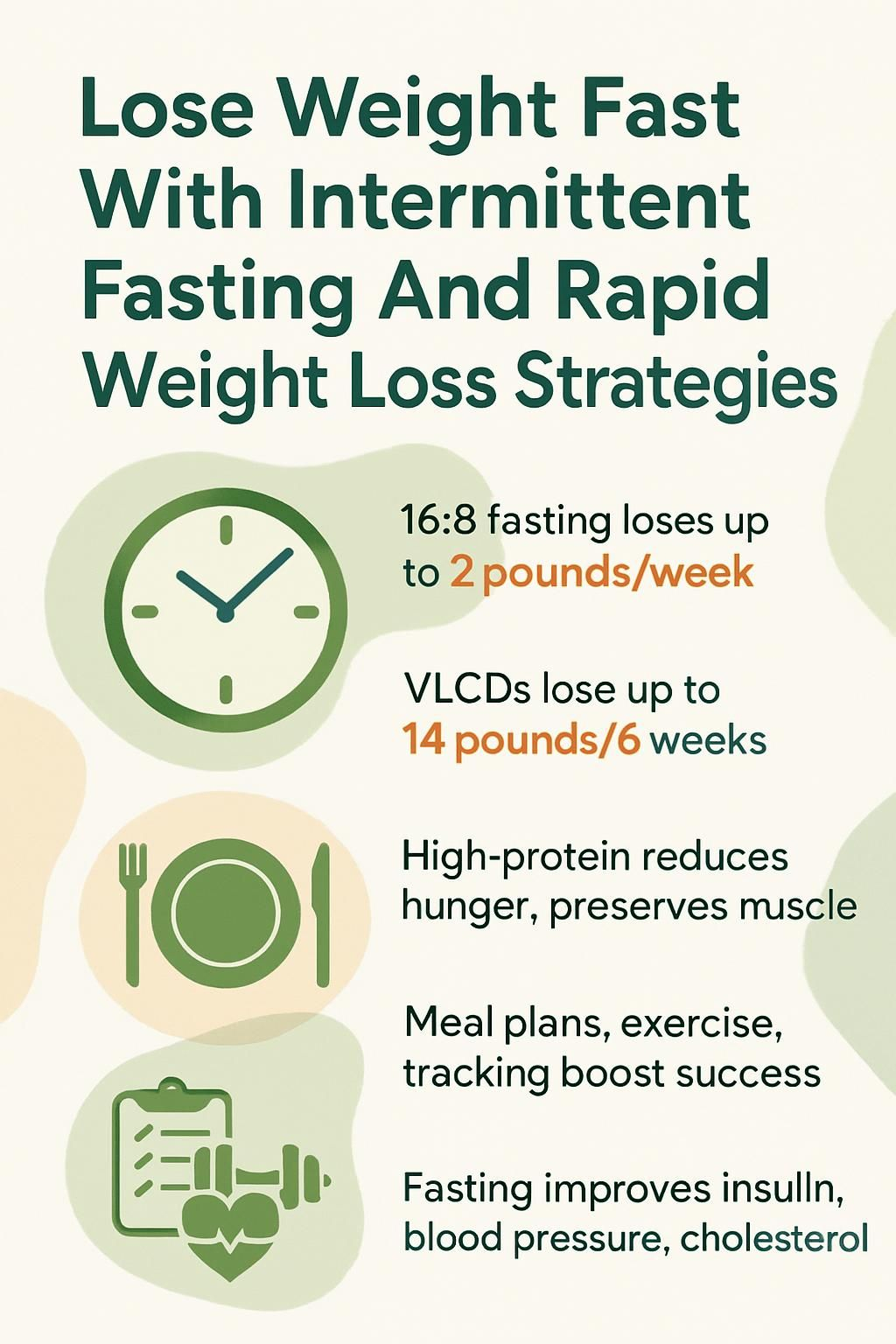Lose Weight Fast With Intermittent Fasting And Rapid Weight Loss Strategies
Our Nutrition Assistant AI Suite will transform your body. You will lose fat, get toned, and build muscle. Gain confidence and optimal health.
You may want to lose weight fast because extra pounds drain your energy, affect confidence, or raise health concerns. Intermittent fasting is a practical eating plan that limits when you eat, not every specific food. Many people use it for weight loss and better weight management, and it can fit a busy life.
This article explains how intermittent fasting and other rapid weight loss approaches work. You will learn tips to help you burn more calories, choose smart foods, and build habits that last. Use the steps to start your path to a healthier life today.
Start your journey to healthy weight loss today.
Key Takeaways
- Popular intermittent fasting styles, such as 16:8 and 5:2, can support rapid weight loss. In research, people sometimes lose up to 2 pounds per week when they also stay active.
- Very low-calorie diets, about 800 calories per day, require medical supervision. Short programs can lead to double-digit losses before surgery, but risks are higher without a doctor’s care.
- High-protein foods help protect muscle and reduce hunger. Fiber-rich choices slow digestion, and cutting added sugar supports faster, safer fat loss.
- Meal replacements, regular exercise like HIIT or strength training, and food tracking improve results. Several reviews report better outcomes when these tools are combined.
- Sources such as the Mayo Clinic and the CDC report that intermittent fasting may improve insulin sensitivity, blood pressure, and cholesterol, and may lower the risk of type 2 diabetes.

What Is Intermittent Fasting and How Does It Work?

Intermittent fasting means you eat during set hours, then fast during the remaining hours. This pattern can help with weight loss, heart health, and simple meal planning.
What Are the Basics of Intermittent Fasting?
You follow intermittent fasting by choosing an eating window and sticking to it each day. The 16:8 pattern is common. You eat within an eight-hour window, such as 10 am to 6 pm, then fast for 16 hours. This structure limits late-night eating and helps reduce daily calories without strict food rules.
The 5:2 plan is another option. You eat normal amounts five days a week. On two nonconsecutive days, you reduce intake to about 500 to 600 calories. These methods often help you eat less, which supports a steady calorie deficit.
Research suggests these approaches can promote quick weight loss, though long-term effects still need more study. Do not use very rapid weight loss plans without guidance because you could miss key nutrients or lose muscle.
“Fasting windows make it easier to set limits on eating times,” notes experts at Johns Hopkins Medicine.
What Are the Most Popular Intermittent Fasting Methods Like 16:8, 5:2, and Eat-Stop-Eat?
Intermittent fasting uses planned eating and fasting windows to reduce calories. Many people like these methods because they are simple and can work with a regular routine.
- The 16:8 method limits eating to an eight-hour window, such as 10 am to 6 pm, followed by a 16-hour fast. It offers quick wins with fewer food rules.
- The 5:2 method allows regular eating five days a week. On two separate days, you eat much less, usually 500 to 600 calories.
- Eat-Stop-Eat involves a 24-hour fast once or twice per week. People with diabetes or heart disease should talk with a clinician before trying it.
- All three reduce average calorie intake. Pair them with lean protein during eating windows to help protect muscle while losing body fat.
- Some studies show weekly losses around 1 kilogram, about 2 pounds, when fasting methods are paired with physical activity and a healthy diet.
- Health professionals urge careful monitoring. Rapid loss can raise the risk of nutrient gaps or rebound weight gain, especially with medical conditions.
- Patterns used in healthy plans, such as the Mediterranean style of eating, also focus on whole foods like vegetables, fruits, and whole grains.
Some people combine these methods with calorie-controlled plans for faster results. Understanding how fasting changes fuel use explains why these strategies can be so effective.
How Does Intermittent Fasting Help You Lose Weight Quickly?
Intermittent fasting can be a strong way to lose weight quickly while building habits that last. The structure helps limit calories and supports fat loss.
How Does Intermittent Fasting Enhance Metabolism?
During fasting, your body first uses stored glycogen, a form of glucose in the liver and muscles. After about 10 to 12 hours, glycogen drops, and your body taps more fat for fuel. This shift supports higher fat use across the day.
Hormones also change. Insulin falls when you are not eating, which makes it easier to access stored fat. Growth hormone may rise, which helps protect muscle during weight loss. Many people report better focus and energy as their body adjusts.
Mayo Clinic experts note that fasting can encourage your body to switch fuel sources. Regular activity adds benefits because exercise improves mood and sleep, which helps you stick with your plan.
How Does Intermittent Fasting Encourage Fat Burning?
As fasting continues, your body relies less on sugar from recent meals and more on stored fat. Lower insulin sends a clear signal to release fatty acids from fat cells, especially around the abdomen. Studies show fasting for 16 hours or longer can speed this process.
The liver converts fatty acids to usable fuel. Although calorie reduction drives most loss on the scale, fasting helps your body target stored fat. The CDC advises safe methods since extreme loss without support can also reduce muscle or bone.
How Does Intermittent Fasting Reduce Daily Caloric Intake?
Time windows naturally reduce how often you eat. In a 16:8 plan, you might skip a routine breakfast or late-night snacks. Many “convenience foods,” like soft drinks and pastries, are easy to avoid when your eating window is shorter.
People often aim for a daily deficit of about 500 to 750 calories, which can lead to 1 to 2 pounds of loss per week, according to the American Heart Association. Very low-calorie diets set intake near 800 calories with clinical support. Standard low-calorie plans often range from 1,200 to 1,500 calories for women and up to 1,800 for men.
Eating less often gives your body longer breaks from calories, which supports fat loss and better appetite control. Planning meals during eating windows also reduces mindless snacking at night.
Combining Intermittent Fasting with Fast Weight Loss Techniques
Pair intermittent fasting with proven tactics to accelerate progress. Small wins add up when your eating plan and activity work together.
What Is Time-Restricted Eating and How to Adopt It?
Time-restricted eating limits your meals to a set window each day, such as 10 am to 6 pm. It is a simple way to create structure, though long-term outcomes still need more study.
- Choose a window that fits your life, like eight hours from 10 am to 6 pm.
- Eat all meals and snacks inside that window. Outside the window, stick to water, black coffee, or unsweetened tea.
- Pick nutrient-dense foods guided by MyPlate. Focus on protein, whole grains, fruits, vegetables, and fiber.
- Skip sugary drinks and highly processed snacks to reduce excess calories.
- Track your window and meals in an app or journal for accountability.
- Add physical activity such as brisk walking or strength work for better results.
- Talk with your clinician if you have diabetes, obesity, or take medicines that affect blood sugar.
- Watch your energy. Many people feel more stable after a week or two.
- Avoid extreme fasting. Too much restriction can cause nutrient gaps and muscle loss.
- Keep your window steady day to day. Routine helps your appetite cues.
I used an eight-hour window with a simple workout plan for three weeks. Night snacking dropped, and I lost about four pounds without feeling deprived.
How to Follow a Very Low-Calorie Diet (VLCD)?
A very low-calorie diet, about 800 calories per day, can drive rapid loss for short periods. This approach is usually used before bariatric surgery or for severe obesity. It must be supervised to protect your health.
- Find a doctor before you start. Clinical oversight is essential.
- Use meal replacements, such as shakes or soups, for most meals. These provide set calories and core nutrients.
- Limit the plan to 12 weeks or less, as expert guidance recommends.
- Drink enough water each day to support hydration.
- Choose higher protein options to help protect muscle.
- If you have diabetes, monitor blood sugar closely. Medicine needs may change.
- Track progress weekly with weight and activity notes.
- Reduce added salt and refined carbs to avoid fluid swings.
- Meet your care team often to check for side effects like dizziness or fatigue.
I followed a supervised VLCD for six weeks before weight loss surgery. I lost nearly 14 pounds and needed regular lab checks to stay safe and keep my energy steady.
What Are the Benefits of a Low-Calorie Diet (LCD)?
A low-calorie diet can help you lose weight without extreme restriction. Many women do well at 1,200 to 1,500 calories per day. Many men do well at 1,500 to 1,800 calories per day. These ranges are easier to maintain and still lead to steady fat loss.
LCDs can combine meal replacements with regular food. Research shows that reducing daily calories helps people lose weight and improve blood sugar and heart risks. Systematic reviews and meta-analyses support calorie control for safe weight loss[1].
Many people feel better as their body adapts. An LCD is often easier to keep long term than strict or fad diets that promise quick fixes.
[1] Evidence summaries on calorie restriction for overweight adults seeking safe, efficient loss.
How Do Meal Replacement Plans Support Weight Loss?
Meal replacements, such as shakes, bars, or soups, give you fixed calories and a known nutrient mix. They are common in both VLCD and LCD plans because they simplify choices and reduce guesswork.
Replacing two meals per day can shrink daily intake with less planning. In several trials, people using meal replacements lost more weight in 3 months than those using regular food alone. The structure helps you resist high-sugar foods and stay consistent with your goal.
Balanced formulas lower the risk of vitamin and mineral gaps compared with skipping meals. Add regular activity to protect muscle and improve results. These plans suit many adults who want faster progress, but they are not ideal for children or people with complex medical needs without clinical support.
What Should You Eat to Support Weight Loss?
Food choices shape every part of your plan. Smart picks help your heart, blood vessels, and metabolism while making the eating window easier to follow.
Why Are High-Protein Foods Important for Weight Loss?
Protein helps control hunger and protects muscle while you lose weight. Muscle tissue burns more calories than fat, even at rest. Keeping muscle helps you burn more energy across the day.
High-protein meals reduce the chance of regaining weight after rapid loss. Choose lean meats, eggs, fish, yogurt, tofu, or beans. These foods help you feel full, which makes it easier to avoid sugary snacks and refined carbs.
During one fasting phase, I ate grilled chicken at lunch most days. It kept me satisfied until dinner with fewer snacks. Protein-rich choices are a key part of any rapid plan.
How Do Fiber-Rich Foods Help Weight Loss?
Fiber adds volume and slows digestion, so you feel full on fewer calories. Fruits, vegetables, beans, and whole grains help you reach this goal. Aim for several servings of produce every day to support appetite control.
Fiber helps steady blood sugar and supports a healthy gut. Since fiber is not fully digested, it reduces calorie absorption from meals and helps reduce overeating later. When I shifted to bean-and-greens lunches, cravings fell, and losing 10 pounds over several weeks felt more manageable.
Higher fiber intake also supports cholesterol control as part of balanced eating. Many people who hit fiber targets have lower weight regain risk over time[2].
[2] Dietary Guidelines for Americans, USDA/HHS, 2020.
How Can Cutting Sugar and Refined Carbs Aid Weight Loss?
Limiting added sugar reduces calories and helps control hunger. Sources include sodas, candies, and sweet baked goods. The American Heart Association suggests less than 25 grams per day for women and 36 grams per day for men.
Choose whole foods to avoid hidden sugars that disrupt appetite. Replacing white bread and pastries with whole grains steadies energy and reduces crashes. I cut out soda for a month and lost several pounds without changing my exercise plan.
Reducing refined carbs makes it easier to follow your eating window and stick with a healthy diet under stress. More activity plus less sugar is a reliable way to speed progress.
How Does Exercise Affect Weight Loss?
Exercise burns calories and helps shape your body as the scale moves. It also supports mood and sleep, which makes daily choices easier.
What Is High-Intensity Interval Training (HIIT) and Its Benefits?
High-Intensity Interval Training mixes short bursts of hard work with brief rest. For example, sprint for 30 seconds, then walk for 60 seconds, and repeat. This method delivers strong results in less time than steady cardio.
Research shows HIIT can improve heart health and raise calorie burn during and after the workout. A session often lasts 20 to 30 minutes, which helps you reach the weekly goal of 150 minutes of moderate activity. Many people prefer it because it fits busy schedules and boosts fat loss.
How Does Strength Training Enhance Fat Loss?
Strength training builds and preserves muscle, which raises your resting metabolism. When muscles rebuild after training, the repair process burns extra energy. People who lift weights at least twice a week often lose more body fat than those who only do cardio.
Include squats, push-ups, rows, or machines. I started with two short dumbbell sessions each week. My clothes fit looser in a month, even without big calorie cuts.
Each pound of muscle burns a few extra calories per day at rest. Over time, this helps your daily activities use more energy with the same effort.
What Daily Physical Activities Can Help Lose Weight?
Small habits add steady calorie burn to your day. These moves help you hit goals without long gym sessions.
- Choose stairs over elevators. Short climbs raise your heart rate.
- Park farther away. Extra steps add up across a week.
- Stand during phone calls to engage more muscles.
- Move during TV breaks with stretches or bodyweight moves.
- Wear comfortable clothes that make it easy to stay active.
- Schedule exercise like any other appointment.
- Do chores such as sweeping or yard work to increase movement.
- Walk after meals to aid digestion and control appetite.
- Use a standing desk for part of the day to limit long sitting.
I began walking my kids to the bus in the morning. With fasting, I lost about 0.5 to 1 pound per week. Consistency turned small actions into measurable progress.
What Other Methods Can Help You Lose Weight Quickly?
A few simple habits support rapid weight loss when paired with intermittent fasting. These tools help you manage hunger, mood, and routine.
Why Is Staying Hydrated Important for Weight Loss?
Drinking enough water can reduce hunger and support fat loss. Your body sometimes confuses thirst with hunger. A glass of water before meals can reduce intake at that meal.
Hydration supports metabolism and exercise performance. Keeping a water bottle nearby helped me avoid sugary drinks while fasting. That one change made staying on track easier.
How Does Mindful Eating Support Weight Loss?
Mindful eating means paying attention to hunger and fullness. Eat slowly and notice each bite. This gives your brain time to sense fullness so you stop sooner.
Pre-portion snacks instead of eating from the bag. Identify triggers for emotional eating, such as stress or boredom, and pick a plan to handle them. Studies link mindful eating with a lower body mass index over time.
How to Effectively Monitor Weight, Diet, and Exercise?
Tracking helps you see what works, adjust sooner, and stay accountable. Consistent data makes plateaus easier to solve.
- Log meals in an app or notebook each day.
- Use a tracker or watch to record steps and exercise.
- Weigh at the same time daily, such as before breakfast.
- Set weekly goals for calories and activity minutes.
- Review logs weekly to spot helpful or harmful patterns.
- Write short notes on mood, hunger, and sleep.
- Share progress with a coach or supportive friend.
- Adjust quickly when data shows a stall.
I used a paper food diary for two months, then switched to an app. Tracking showed hidden snacks I used to miss, and my results improved.
What Are the Best Ways to Manage Stress for Weight Loss?
High stress can slow fat loss and trigger overeating. Managing stress keeps your plan on track and protects sleep.
- Reach out to a healthcare professional if stress feels unmanageable.
- Practice deep breathing daily to calm the body and lower cortisol.
- Make time for physical activity to reduce tension and lift mood.
- Notice if you use food to cope and replace it with a positive habit.
- Use a journal to find triggers and plan responses that do not include eating.
- Prioritize sleep, since poor sleep increases stress and hunger.
- Try brief mindfulness meditation to control anxiety and support healthy choices.
Next, see how intermittent fasting may improve health markers while you work toward rapid results.
What Are the Health Benefits of Intermittent Fasting and Quick Weight Loss?
Intermittent fasting and quick weight loss often improve both physical and mental well-being. Progress can motivate you to keep going.
How Does Intermittent Fasting Boost Insulin Sensitivity?
During fasting, your body releases less insulin. Cells get a break from constant insulin exposure and respond better later. Studies show intermittent fasting can lower blood sugar and improve insulin sensitivity in people with prediabetes or type 2 diabetes.
Your muscles use stored glucose during eating windows, which may reduce fat around organs and improve how your body handles sugar after meals. Many people notice more stable energy and fewer cravings.
In one case, a person with rising blood sugar tried 16:8 fasting along with medical advice. After three months, fasting glucose and A1C improved without new medications. Similar benefits appear across different fasting methods in research.
How Can Quick Weight Loss Lower Risk of Chronic Diseases?
Quick weight loss can lower risk factors for diabetes, high cholesterol, and high blood pressure. Clinicians often use rapid loss before surgery to improve outcomes. Losing 5 to 10 percent of body weight can reduce blood sugar, LDL cholesterol, and systolic blood pressure.
Some programs use VLCDs with intermittent fasting for short periods to speed results. Under supervision last year, my blood pressure moved from the high range into normal within three months. Measurable changes can happen fast when a plan is supervised and consistent.
Why Does Intermittent Fasting Increase Energy Levels?
Fasting can raise alertness and improve focus. As your body adapts, it relies more on stored fat and less on frequent sugar spikes. This steadies energy and reduces mid-afternoon slumps.
Exercise often improves stamina and mood while fasting. Many people report better sleep, which supports higher energy the next day. I slept more deeply after moving dinner earlier, which made morning workouts easier.
What Are the Risks and Concerns of Quick Weight Loss?
Rapid methods can work, yet they also carry risks. Make safety your first priority, and involve a professional when needed.
What Are the Risks of Nutritional Deficiencies?
Very low-calorie diets can lead to loss of fat, muscle, water, and even bone density. Missing key nutrients raises the risk of fatigue, hair loss, and weak muscles. Low intake of iron, calcium, vitamin D, or potassium can cause problems such as headaches or irregular heartbeat.
Unsupervised rapid loss weakens the immune system and raises the chance of illness. Children and teens are still growing, so they need careful guidance and full nutrition. If you use fasting or a very low-calorie plan, ensure enough protein, fiber, healthy fats, fruits, and vegetables.
Why Does Weight Regain Happen After Rapid Weight Loss?
After rapid loss, your metabolism can slow, and hunger hormones can rise. This makes eating more likely and weight regain common. Fast or strict plans are hard to maintain, and many people return to old habits.
Studies show a high rate of regain after very low-calorie programs within two years. This pattern is why sustainable habits matter for keeping the weight off.
Who Should Avoid or Be Cautious with Quick Weight Loss Methods?
Some groups face higher risks with rapid weight loss. Caution protects your long-term health and safety.
- Children and teens should avoid rapid diets unless a clinician approves them, since growth needs full nutrition.
- Pregnant people should not restrict heavily, which can harm both the parent and baby.
- Adults over 65 need steady nutrients for bone, muscle, and immune health.
- Anyone with diabetes or chronic illness must get medical advice before fasting or rapid plans.
- People taking medications should check for interactions or side effects from sudden diet changes.
- Anyone with an eating disorder history should avoid extreme methods that may trigger old behaviors.
- Athletes or heavy labor workers may have performance and injury risks on very low-calorie plans.
- If you feel dizzy, weak, or have heart palpitations during fasting, stop and seek medical help.
I paused fasting during workouts after feeling light-headed. Talking with my doctor helped me find a safer approach.
How to Maintain Weight Loss Long-Term?
Long-term success comes from steady habits, clear goals, and flexible planning. Simple routines help you protect the progress you worked for.
How to Set Achievable Weight Loss Goals?
Realistic goals keep you focused and motivated. Clear targets also make changes easier to measure.
- Start with 5 percent of your current weight. If you weigh 180 pounds, aim to lose about 9 pounds.
- Target 1 to 2 pounds per week. This pace is both safe and effective.
- Write a specific goal with a timeline you can track.
- Break big goals into smaller steps so wins come often.
- Track food, workouts, and weekly weigh-ins to see trends.
- Set process goals, such as four workouts per week or five home-cooked dinners.
- Reward milestones with non-food treats, such as new shoes or a massage.
- Adapt as needed. Adjust the plan instead of quitting after setbacks.
- Stay patient. Consistency builds health and confidence over time.
Why Is Consistency Key for Long-Term Weight Loss?
Consistent meals and regular workouts train your appetite and improve hormone balance. People who keep stable routines regain less weight than those who rely on short bursts of effort.
Meal planning and scheduled exercise help prevent last-minute choices that derail progress. A steady plan helps rapid weight loss turn into lasting change.
What Lifestyle Changes Support Sustainable Weight Loss?
Sustainable loss depends on habits that fit your life. Build routines that make healthy choices the easy choices.
- Track eating patterns to find triggers such as stress snacking, then plan how to respond.
- Commit to your plan before starting. Readiness supports long-term success.
- Choose realistic targets, such as 1 to 2 pounds per week.
- Plan meals and shop with a list to reduce impulse choices.
- Increase daily steps. Higher step counts link to lower body fat over time.
- Strength train twice weekly to protect muscle and metabolism.
- Manage stress with simple tools because high stress drives overeating.
- Get 7 to 9 hours of sleep. Poor sleep disrupts hunger hormones.
- Build a support system for encouragement during tough weeks.
- Adjust after setbacks. Small corrections keep progress moving.
Common Questions About Intermittent Fasting and Rapid Weight Loss
You may have questions before you start. These answers offer clear guidance so you can move ahead with confidence.
Is Intermittent Fasting Suitable for Everyone?
Intermittent fasting is not right for everyone. Children, teens, pregnant people, and older adults should avoid fasting unless a clinician advises it. People with health conditions or those on certain medications should seek guidance because fasting can affect blood sugar and blood pressure.
If you take medicines or have a health condition, talk with your doctor first. I tried fasting without checking and felt dizzy. A quick visit helped adjust my plan and medication schedule.
Summary: Intermittent fasting offers benefits, but some groups need medical guidance before starting.
How Much Weight Can You Lose in One Month?
Results vary with your plan, body, and consistency. Many experts consider 0.5 to 1 pound per week safe. Over a month, that equals about 2 to 4 pounds.
Under medical care, a very low-calorie diet can lead to 3 to 5 pounds per week, or 12 to 20 pounds in four weeks. With time-restricted eating, an LCD, and more daily steps, I lost nearly six pounds in four weeks without feeling worn down.
Discuss rapid approaches with your healthcare provider before you begin.
Are Rapid Weight Loss Practices Safe?
Rapid methods can work but may raise risks if done alone. Doctors often use them for people with obesity who need fast results, such as before surgery. Very low-calorie diets can cause nutrient gaps, muscle loss, gallstones, and shifts in electrolytes.
Most people do best with a slower approach unless they have a specific medical reason. During a supervised two-week meal replacement plan before knee surgery, my labs and vital signs were closely monitored. Medical teams track heart health, hydration, blood sugar, and nutrition to protect you during rapid loss.
Conclusion
Intermittent fasting pairs well with rapid weight loss strategies when you keep nutrition, movement, and safety in focus. Use high-protein foods, plenty of fiber, and less added sugar. Keep a steady eating window, and add exercise that fits your schedule.
Consistency matters. Track your meals and activity, adjust when needed, and seek medical guidance before strict plans. With a clear routine and simple tools, you can lose weight quickly and build habits that support your long-term health.
FAQs
1. What is intermittent fasting and how does it help with rapid weight loss?
Intermittent fasting involves scheduled periods of eating and fasting. Research shows that this method can reduce calorie intake, improve insulin sensitivity, and promote fat burning. A study in the New England Journal of Medicine found that time-restricted eating may support weight loss by helping people consume fewer calories each day.
2. Are there risks linked to rapid weight loss strategies?
Rapid weight loss methods can lead to muscle loss, nutritional deficiencies, or gallstones if not managed carefully. The Centers for Disease Control and Prevention recommends losing one to two pounds per week for safe results. Consulting a healthcare provider before starting any fast-paced plan helps prevent health issues.
3. How do I start intermittent fasting safely?
Begin with a simple schedule such as 16 hours of fasting followed by an eight-hour window for meals. Drink water during fasting times to stay hydrated; choose nutrient-rich foods when you eat. My own experience showed better focus after adjusting meal timing gradually over several weeks.
4. Can combining exercise with intermittent fasting speed up results?
Pairing regular physical activity with intermittent fasting often leads to greater fat reduction than either approach alone according to research published in Obesity Reviews journal. Strength training preserves lean tissue while aerobic workouts increase calorie burn during both feeding and fasting windows.
Summary: Intermittent fasting supports quick yet sustainable weight management when paired with balanced nutrition and exercise routines; always consult medical professionals before making major changes to your diet or lifestyle.







